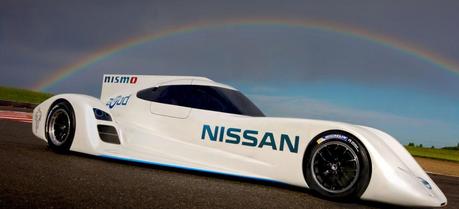 Odds are, this technology will help create a new battery for the Nissan ZEOD hybrid electric racing car. (Credit: Nissan)
Odds are, this technology will help create a new battery for the Nissan ZEOD hybrid electric racing car. (Credit: Nissan)Nissan Motor Company and its affiliate Nissan Arc Ltd. announced the development of what they call the world’s first analysis method that enables direct observation of electron activity in the cathode material of lithium ion batteries during charging and discharging.
According to the company’s press release, applying this analysis technique to future research and design of battery materials could enable Nissan researchers to develop high-capacity and high-durability batteries that may extend the driving distance of EVs and improve their durability.
Nissan Arc Ltd., a 100-percent subsidiary of Nissan Motor Company, developed the analysis method in a joint R&D effort with Tokyo University, Kyoto University and Osaka Prefecture University. The newly-developed technique provides an accurate depiction of how electrons are emitted from certain elements that constitute the cathode material of lithium ion batteries when charging and discharging.
Takao Asami, Nissan senior vice president and president of Nissan Arc Ltd., said: “Creating this analysis technique was a major step toward the further development of high-capacity, next-generation lithium ion batteries. It will play an important part in our future R&D aimed at extending the driving range of future zero emission vehicles.”
In order to develop high-capacity, long-life lithium ion batteries, the maximum possible amount of lithium must be stored in the electrode’s active material, which allows it to generate the highest possible number of electrons. To develop such a material, an accurate reading of the electron activity inside the battery is essential. Existing analysis methods did not allow researchers to observe the movement of electrons. It was not possible to determine how the various electrodes’ active material—i.e. manganese (Mn), cobalt (Co), nickel (Ni), oxygen (O)—were emitting electrons and how many electrons were actually being emitted.
The newly-developed analysis method combines x-ray absorption spectroscopy that utilizes L-absorption edges and the first principle calculation from Japan’s Earth Simulator supercomputer.
Nissan Arc has used the new analysis technique to investigate lithium-rich high-capacity electrode materials which are considered promising agents to increase energy density by 50%. The analysis revealed that at a high potential state, electrons originating from oxygen were active during charging. Meanwhile, electrons that originated from manganese were observed to be active during the discharge reaction. These findings were a big step forward toward the commercial development of lithium-rich electrode materials which can produce higher-capacity, long-lasting batteries.

